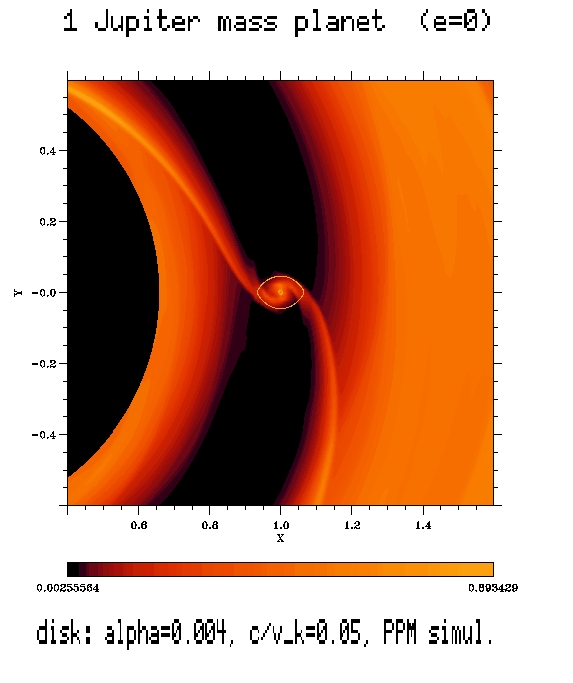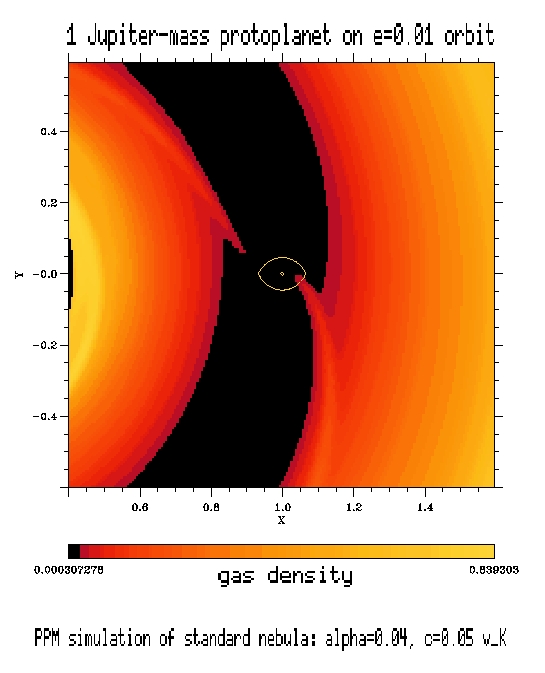As a reminder, tm is the mass doubling timescale of the planet. When given in unints of yr, Jupiter's orbital distance is assumed. Notice that closer-in planets will grow much more rapidly, in proportion to orbital period.
| | mu = 10-3 | e = 0 |
| | alpha = 0.004 | c/vK = 0.05 |
| |
resol.: 0.0080 x 0.0048 | tmax= 72 P |
| | 0.16*(dm/dt)dsk | tm = |
| |
-6· 10-5 vK (inward) | ta= 31 kyr |
| |
+1.3· 10-7 vK (outward) | ta= 14 Myr |
| | const. | - |



Comments:
Gap is open in agreement with all kinds of criteria.
Mass flows through the gap. The accretion rate is intermediate.
The boundary conditions inside the Roche lobe are such that
only 3% of the mass is removed per dynamical time scale of the planet
(or P/2/pi) inside the radius 0.6 rL from the planet.
The actual accretion may proceed faster, depending
on circumplanetary disk properties. Here, some pressure gradient
builds inside the simulated Roche lobe and moderates the accretion,
which may be unrealistic. The next model deals with this problem
by assuming a faster removal of gas.
Spiral shocks waves are seen in the gap,
and continue as planet's wake into the disk forming nonlinear acoustic waves.
| | mas ratio µ = 10-5 | e = 0.01 |
| | alpha = 0.008 | c/vK = 0.025 |
| |
resol.: 0.013 x 0.0012 | tmax= 140 P |
| | (dm/dt)dsk=3 pi Sigma nu | = 3.2· 10-8 Msun/yr |
| | 1.3*(dm/dt)dsk | tm = 24 kyr |
| |
2.0· 10-5 vK | ta= 94 kyr |
| | de2/dt=-2· 10-6 /tdyn | te= ? yr |

| | mass ratio µ = 3 · 10-3 | e = 0.01 |
| | alpha = 0.004 | c/vK = 0.05 |
| |
resol.: 0.02 x 0.02 | tmax= 100 P |
| | dm/dt= 0.5 × (dm/dt)0 | tremove = 0.02 P (max. efficient) |
| |
(dm/dt)0 = 3 pi Sigma nu | nu = 10-5 |
| - | (dm/dt)0 = 6 · 10-8 Msun/yr | - |
| | tm = 0.19 Myr | ! |
| |
da/dt = -5.5 · 10-6 vK (inward) | ta= 0.340 Myr |
| |
da/dt = +1.6 · 10-6 vK (outward) | ta= 1.2 Myr , adv < grav (=> inward) |
| |
v = -1.5 · 10-5 vK | tvisc= 0.13 Myr |
| |
de2/dt = +-3 × 10-8 (noisy) | grav = adv (?) |
| |
de2/dt = -3.2 × 10-8 | te = 12 kyr |